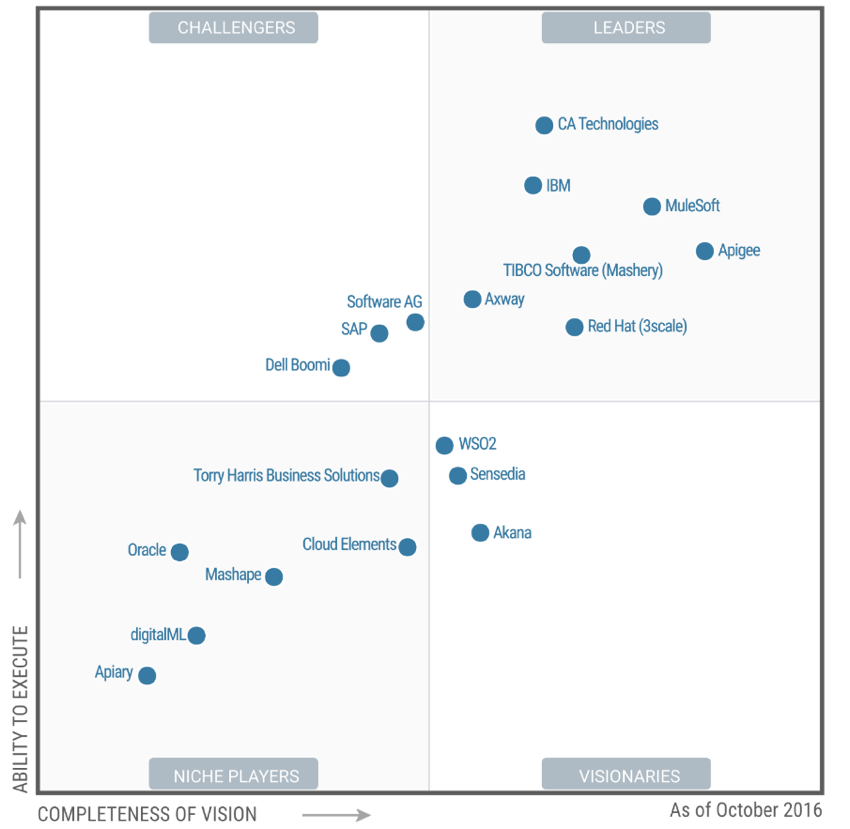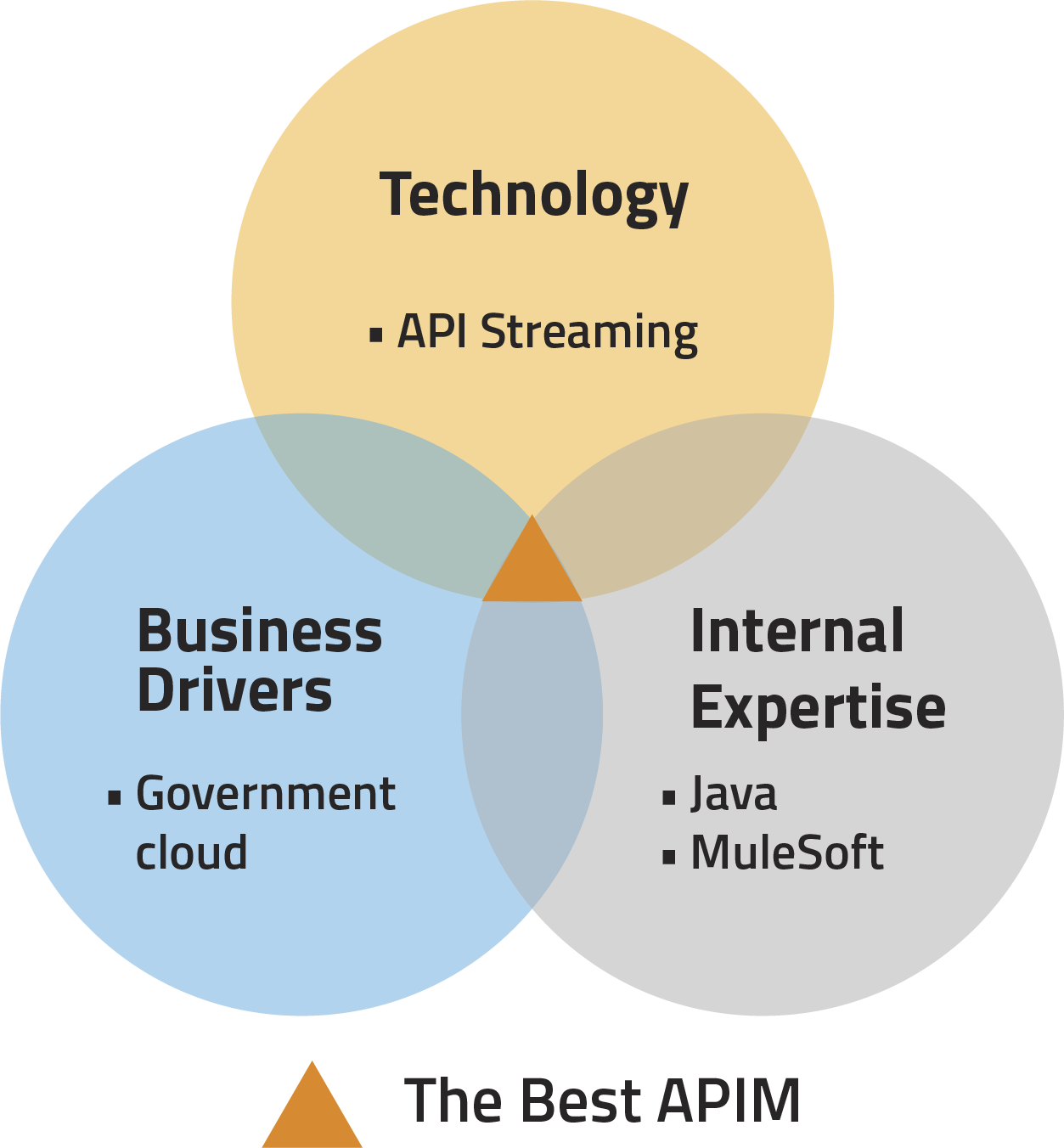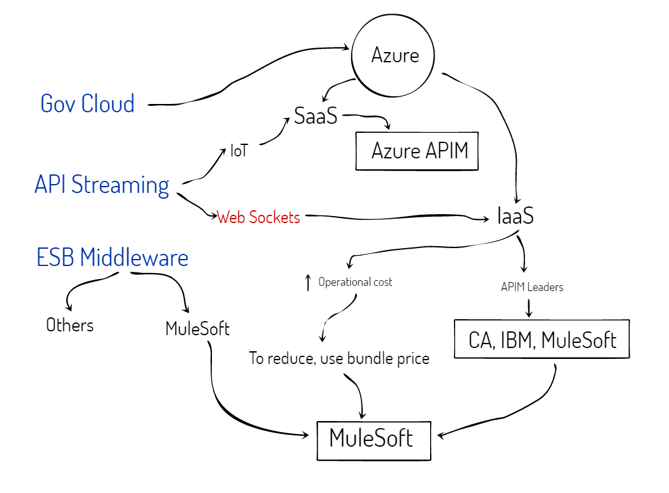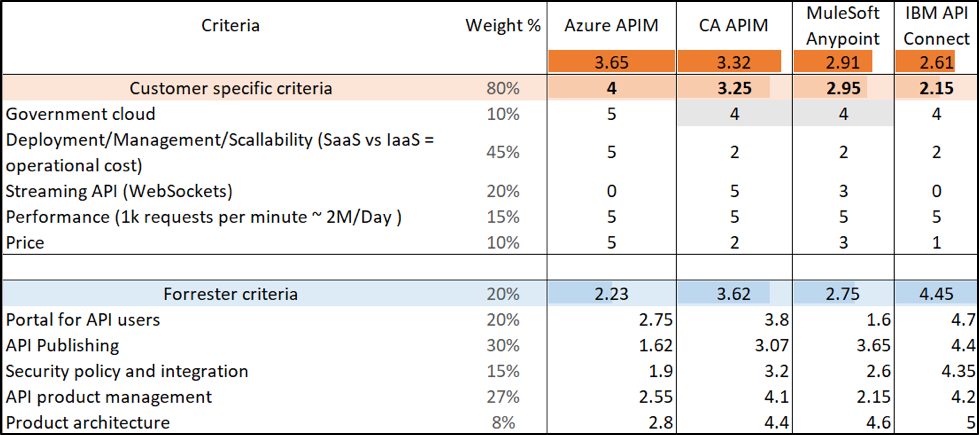The API management market is a hot one. As more organizations make investments in mobile, IoT, and big data, APIs are a core of their digital strategy. To secure and manage the use of APIs, API management solutions are a must. Forrester predicts that U.S. companies will spend nearly $3 billion on API management solutions before 2020 – and the vendor landscape is poised and ready to capitalize on this growth.
But how do you choose the best API management (APIM) solution for your needs? Let’s take a look at your options, the pitfalls of traditional decision-making processes, and introduce an approach that stresses traceable logic in the API vendor management selection so you get the best APIM solution for your needs.
Should You go the Leadership Recognition Route?
The traditional approach of a feature-by-feature comparison is hardly practical given the field of players to choose from. In 2016 alone, Gartner qualified 19 vendors to its Magic Quadrant for Full Life Cycle API Management, with seven leaders and a scattered array of others either making a play for the leader quadrant of losing ground.

The 2016 Gartner Magic Quadrant for Full Life Cycle API Management includes two new leaders in 2016 – IBM and Red Hat (3scale), while Tibco (Mashery) and Axway are losing progress.
Below is the rest of the field which includes four new vendors added since 2015.

Courtesy of Gartner.
Not only are we seeing more vendors entering the Quadrant, vendors are also becoming more active. A flurry of acquisitions over the past two years confirms the increasing importance of APIM. For example, Apigee has entered into a definitive agreement to be acquired by Google, Red Hat acquired 3scale, Axway acquired Appcelerator, and Mashery has been through two acquisitions in as many years!
But something is afoot. If you look at the Quadrant once more, notice anyone missing? The big players are notably absent. There’s no AWS or Azure, neither of whom met the revenue criteria to be included. Nevertheless, if you’re already in one of these mega-vendor’s cloud, it’s important to take them into account when assembling your APIM vendor shortlist.
How Does APIM Maturation Figure into your Decision?
As the market grows, so does product maturation. Today, you can purchase full lifecycle APIM offerings that include planning, design, implementation, publication, operation, consumption, maintenance, and API retirement.
We are also witnessing the convergence of APIM capabilities with hybrid integration platforms, mobile app development, and enterprise service bus (ESB). Open source APIM solutions are also emerging.
And, as we look to the future, market leaders are increasingly recognizing that an end-to-end API platform doesn’t just serve as a gateway (managing data in and out), but also as an embedded tool to facilitate flexible API creation and composition. Finally, the IoT conversation will also take place in the context of any API strategy, since API is a workhorse behind IoT.
All these developments bring about more complex scenarios for any APIM solution to support.
How Do You Circumnavigate Vendor Bias?
Inevitably, organizations can expect to face even more choices in the rapidly evolving APIM market, but one way in which vendors are likely to differentiate themselves is by providing more strategical and technical consulting to help buyers with the decision-making process. Of course, you can fully expect this approach to mold the buyer’s case into an existing product in the vendor’s portfolio.
To counteract the introduced bias from pre-sale APIM vendors, enterprises can embark on their own independent research. Here you have a few options:
- Ask for advice from an independent software vendor (ISV) whom you already have a trusted relationship with.
- Strip all bias from the equation by consulting a well-regarded authoritative research or advisory firm like Gartner and Forrester (unfortunately, it’s a costly approach that is typically limited to large enterprises with deep pockets).
- Scour vendor websites for re-printed versions of market analysis reports. Although, be aware that these reports are for general orientation and lack an evaluation system to help you select the best APIM for your needs.
- Consult crowdsourcing sites, such as IT Central Station, where APIM professionals search for and share their APIM comparison findings.
Each are useful resources, but they exclude several vital components that should be central to any purchasing decision – your needs, strategy, internal capabilities, and peer-to-peer decision-making process.

A Better Way: Try Our Vendor Agnostic 3-Step Approach to Choosing an API Management Platform
As a technology-agnostic solution provider, we encounter these kinds of APIM selection challenges every day, and we’ve come up with a better way for selecting an APIM solution, one that has served our clients well.
The EastBanc Technologies approach begins with determining how relevant your research or collaborative efforts with API vendors is to your overall API strategy. Every piece of research you do or advice you receive will always make a case or offer an argument for a particular APIM solution, it’s down to you to determine if this makes sense in the context of your needs. To do this, we suggest the following three-step approach:
1. Specify the forces that will define technical and non-technical requirements of the solution.
These forces will typically fall into three buckets: business drivers, internal expertise, and technical capabilities. Below is an example of how these unique requirements – business, internal expertise, and technical – come together to define the appropriate APIM solution based on your API strategy and the key boxes it must check.

2. Mind-map your line of reasoning, so you can see how the chains of argument fit together.
The mapping allows you consolidate your unique factors for decision-making, as well as to validate with other stakeholders the completeness of the requirements.
Below is a sample mind-map for an APIM platform selection based on three major requirements: Gov Cloud, API streaming, and ESB middleware.

3. Visualize the decision-making processes for a quick consensus.
Next, assemble your vendor shortlist and discuss. This is where analyst reports (like Gartner’s Magic Quadrant for Full Life Cycle API Management) play a vital role in helping you understand player’s strengths and weaknesses. (If you don’t have membership, visit the “Resources” section of a vendor website. They’ll be happy to brag about their position and are likely to have free re-prints).
Now compare your vendor research with your unique criteria and weighting. Below is a useful matrix from Forrester Wave that can help with this stage. This analysis takes time but it’s guaranteed to ensure that you arrive at the right solution for your needs before you commit to one, not as an afterthought when the platform fails to deliver value.

Sample decision matrix combining unique customer’s requirements and their weighting with the Forrester rating.
This matrix methodology will also ensure you achieve consensus among stakeholders during the early stages of the project. With a visual representation of your selection criteria and rankings it becomes easier to foster discussion and counter-arguments, and ultimately achieve buy-in before investing in a product and its integration. After all, as Forrester Wave: API Management Solutions Q4 2016 stresses: “Diverse enterprise API scenarios mean that one buyer’s treasure is another’s trash.”
Conclusion
If you’re in the market for an APIM solution, give our three-step process a try. This kind of argumentation transparency builds common ground by helping you better understand the cornerstones of your digital strategy and the reasons behind your vendor selection process. You can also archive your decision-making artifacts for future reference so you can easily refresh your criteria or modify the model, leading to a potential vendor switch. If your strategy changes, and the platform no longer serves it, our approach makes it easier to communicate these findings.